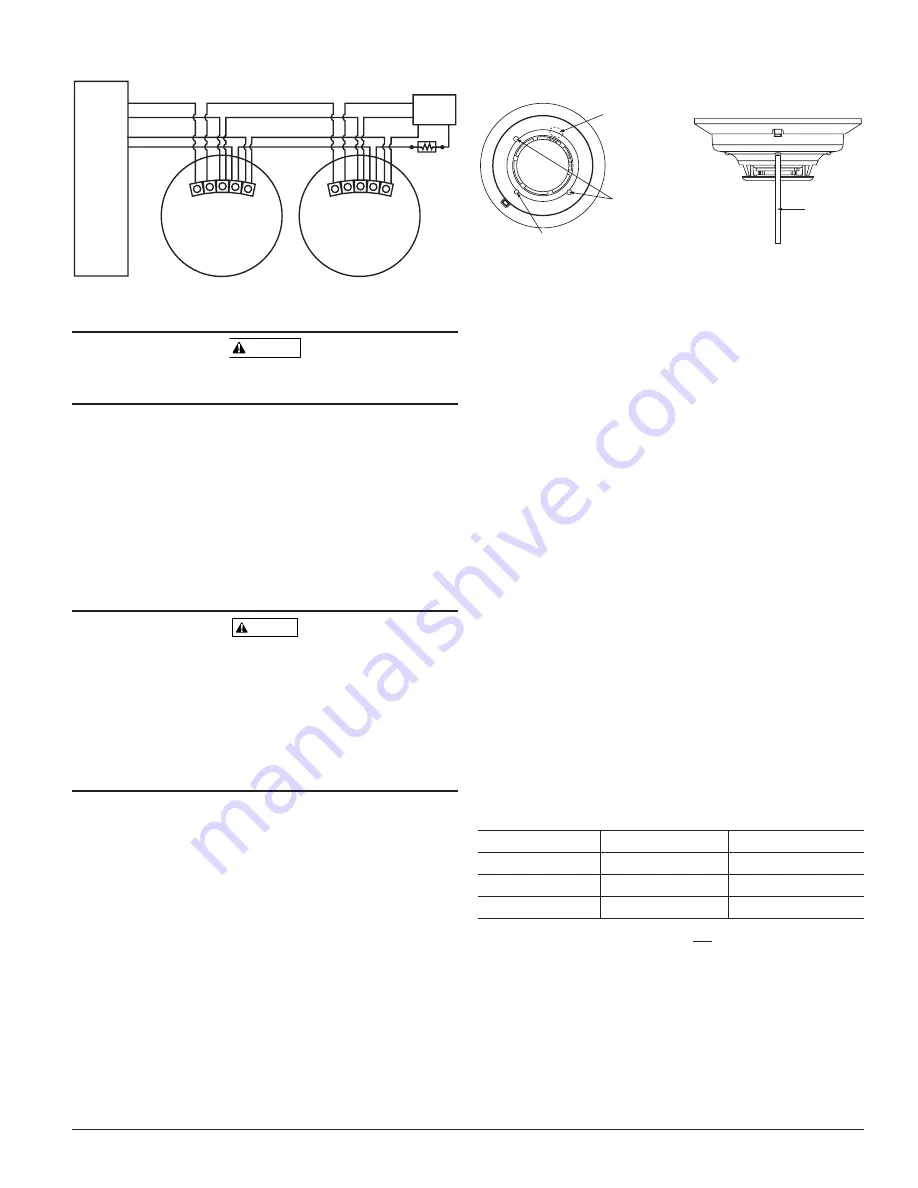
D100-96-00 3 I56-1800-07R
Figure 3b: Wiring Diagram, 4W-B and 4WT-B
AUX OR
SMOKE
POWER
IDC
4-WIRE
CONTROL
PANEL
+
+
–
–
4W-B or
4WT-B
(5
) COM
(4
) NO
(3
) – IN/OUT
(2
) + OUT
(1
) + IN
EOL
RELAY
(A77-716B)
EOL
RESISTOR
4W-B or
4WT-B
(5
) COM
(4
) NO
(3
) – IN/OUT
(2
) + OUT
(1
) + IN
S0134-00
Installation
WARNING
Remove power from alarm control unit or initiating device circuits
before installing detectors.
NOTE:
To install units so that corresponding LEDs are lined up,
refer to the “Green LED” indicator on the base.
1. Wire the mounting base screw terminals per Figure 3a or
Figure 3b, as applicable.
2. Place detector on the base and rotate clockwise. The detector
will drop into the base and lock into place with a “click”.
3. After all detectors have been installed, apply power to the
alarm control unit.
4. Test each detector as described in
Testing.
5. Reset all the detectors at the alarm control unit.
6. Notify the proper authorities that the system is in operation.
CAUTION
Dust covers are an effective way to limit the entry of dust into
the smoke detector sensing chamber. However, they may not
completely prevent airborne dust particles from entering the
detector. Therefore, System Sensor recommends the removal of
detectors before beginning construction or other dust producing
activity. When returning the system to service, be sure to remove
the dust covers from any detectors that were left in place during
construction.
Testing
Detectors must be tested after installation and following
maintenance.
NOTE:
Before testing, notify the proper authorities that mainte-
nance is being performed and the system will be temporarily out
of service. Disable the zone or system undergoing maintenance to
prevent any unwanted alarms.
Ensure proper wiring and power is applied.
After power up, allow
80 seconds for the detector to stabilize before testing.
Test i
3
Series detectors as follows:
A. Test Switch
1. An opening for the recessed test switch is located on the
detector housing (See Figure 4).
2. Insert a small screwdriver or allen wrench (0.18
″
max.) into
the test switch opening; push and hold.
3. If the detector is within the listed sensitivity limits, the
detector’s red LED should light within five seconds.
Figure 4: Recessed Test Switch Opening and SENS-RDR
Position
PUSH RECESSED
SWITCH WITH A
0.18
″
MAX.
DIAMETER TOOL
LED
RECESSED TEST SWITCH
POSITION SENS-RDR
AT AN ANGLE ON THE
OVAL AREA OR AT THE
CHAMBER OPENING
BY THE WORD “PAINT”
S0135-00
B. Smoke Entry Test
Hold a smoldering punk stick or cotton wick at the side of the
detector and gently blow the smoke through the detector until
it alarms.
C. Direct Heat Method (models 2WT-B and 4WT-B only)
Using a 1000-1500 watt hair dryer, direct the heat toward either
of the thermistors. Hold the heat source about 12 inches from
the detector to avoid damage to the plastic.
NOTE:
For the above tests, the detector will reset only after the
power source has been momentarily interrupted.
If a detector fails any of the above test methods, its wiring
should be checked and it should be cleaned as outlined in the
Maintenance
section. If the detector still fails, it should be
replaced.
Notify the proper authorities when the system is back in service.
Loop Verification (models 2W-B and 2WT-B only)
Loop verification is provided by the EZ Walk loop test feature.
This feature is for use with i
3
Series compatible control panels or
the i
3
Series 2W-MOD module only. The EZ Walk loop test verifies
the initiating loop wiring and provides visual status indication at
each detector.
1. Ensure proper wiring and power is applied. Wait approxi-
mately six minutes before performing EZ Walk test.
2. Place control panel or module in EZ Walk Test mode (refer
to panel manufacturer’s manual or 2W-MOD manual D500-
46-00).
3. Observe the LEDs on each detector:
Table 3: EZ Walk Test Detector Modes
Green LED
Red LED
Proper Operation
Double blink 5 sec
—
Out of Sensitivity
—
Double Blink 5 sec
Freeze Condition
—
Double Blink 10 sec
NOTE:
The EZ Walk loop test must not be used instead of alarm
testing.
Maintenance
NOTE:
Before performing maintenance on the detector, notify the
proper authorities that maintenance is being performed and the
system will be temporarily out of service. Disable the zone or
system undergoing maintenance to prevent any unwanted alarms.
Power must be removed from the detector before performing
maintenance of any kind.






















